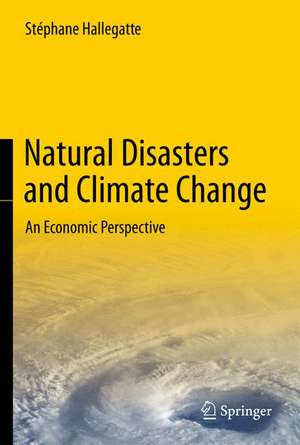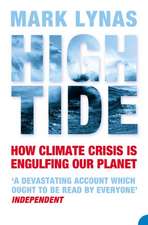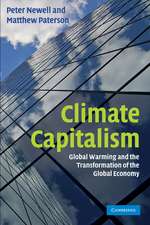Natural Disasters and Climate Change: An Economic Perspective
Autor Stéphane Hallegatteen Limba Engleză Hardback – 29 sep 2014
| Toate formatele și edițiile | Preț | Express |
|---|---|---|
| Paperback (1) | 636.63 lei 6-8 săpt. | |
| Springer International Publishing – 23 aug 2016 | 636.63 lei 6-8 săpt. | |
| Hardback (1) | 642.83 lei 6-8 săpt. | |
| Springer International Publishing – 29 sep 2014 | 642.83 lei 6-8 săpt. |
Preț: 642.83 lei
Preț vechi: 756.27 lei
-15% Nou
Puncte Express: 964
Preț estimativ în valută:
123.02€ • 133.58$ • 103.34£
123.02€ • 133.58$ • 103.34£
Carte tipărită la comandă
Livrare economică 22 aprilie-06 mai
Preluare comenzi: 021 569.72.76
Specificații
ISBN-13: 9783319089324
ISBN-10: 3319089323
Pagini: 180
Ilustrații: XXII, 194 p. 43 illus., 32 illus. in color.
Dimensiuni: 155 x 235 x 15 mm
Greutate: 0.49 kg
Ediția:2014
Editura: Springer International Publishing
Colecția Springer
Locul publicării:Cham, Switzerland
ISBN-10: 3319089323
Pagini: 180
Ilustrații: XXII, 194 p. 43 illus., 32 illus. in color.
Dimensiuni: 155 x 235 x 15 mm
Greutate: 0.49 kg
Ediția:2014
Editura: Springer International Publishing
Colecția Springer
Locul publicării:Cham, Switzerland
Public țintă
ResearchCuprins
1 Introduction and summary.- 2 What is a disaster? An economic point of view.- 3 Disaster risks: evidence and theory.- 4 Trends in Hazards and the Role of Climate Change.- 5 Climate change impact on natural disaster losses.- 6 Methodologies for disaster risk management in a changing environment.- 7 Decision making for disaster risk management in a changing climate.- 8 References.
Recenzii
“Hallegatte’s effort has potential to be recommended to academics and government officials who wish to investigate economic consequences of a disaster and constitute future course of actions considering multiple uncertainties and climate scenarios. We found that the book consists of easy-to-understand theoretical discussions, logical explanations, clear language and impressive illustrations with a combination of vivid economic analysis. We believe that many institutions, academicians, decision makers and earth science scholars would find the book a worthwhile acquisition.” (D. Bhatt, R. K. Mall and T. Banerjee, Natural Hazards, Vol. 78 (1), August, 2015)
Textul de pe ultima copertă
This book explores economic concepts related to disaster losses, describes mechanisms that determine the economic consequences of a disaster, and reviews methodologies for making decisions regarding risk management and adaptation.
The author addresses the need for better understanding of the consequences of disasters and reviews and analyzes three scientific debates on linkage between disaster risk management and adaptation to climate change. The first involves the existence and magnitude of long-term economic impact of natural disasters on development. The second is the disagreement over whether any development is the proper solution to high vulnerability to disaster risk. The third debate involves the difficulty of drawing connections between natural disasters and climate change and the challenge in managing them through an integrated strategy.
The introduction describes economic views of disaster, including direct and indirect costs, output and welfare losses, and use of econometric tools to measure losses. The next section defines disaster risk, delineates between “good” and “bad” risk-taking, and discusses a pathway to balanced growth. A section entitled “Trends in Hazards and the Role of Climate Change” sets scenarios for climate change analysis, discusses statistical and physical models for downscaling global climate scenarios to extreme event scenarios, and considers how to consider extremes of hot and cold, storms, wind, drought and flood. Another sect
ion analyzes case studies on hurricanes and the US coastline; sea-level rises and storm surge in Copenhagen; and heavy precipitation in Mumbai. A section on Methodologies for disaster risk management includes a study on cost-benefit analysis of coastal protections in New Orleans, and one on early-warning systems in developing countries. The next section outlines decision-making in disaster risk management, including robust decision-making, No-regret and No-risk strategies; and strategies that reduce time horizons for decision-making. Among the conclusions is the assertion that risk management policies must recognize the benefits of risk-taking and avoid suppressing it entirely. The main message is that a combination of disaster-risk-reduction, resilience-building and adaptation policies can yield large potential gains and synergies.
The author addresses the need for better understanding of the consequences of disasters and reviews and analyzes three scientific debates on linkage between disaster risk management and adaptation to climate change. The first involves the existence and magnitude of long-term economic impact of natural disasters on development. The second is the disagreement over whether any development is the proper solution to high vulnerability to disaster risk. The third debate involves the difficulty of drawing connections between natural disasters and climate change and the challenge in managing them through an integrated strategy.
The introduction describes economic views of disaster, including direct and indirect costs, output and welfare losses, and use of econometric tools to measure losses. The next section defines disaster risk, delineates between “good” and “bad” risk-taking, and discusses a pathway to balanced growth. A section entitled “Trends in Hazards and the Role of Climate Change” sets scenarios for climate change analysis, discusses statistical and physical models for downscaling global climate scenarios to extreme event scenarios, and considers how to consider extremes of hot and cold, storms, wind, drought and flood. Another sect
ion analyzes case studies on hurricanes and the US coastline; sea-level rises and storm surge in Copenhagen; and heavy precipitation in Mumbai. A section on Methodologies for disaster risk management includes a study on cost-benefit analysis of coastal protections in New Orleans, and one on early-warning systems in developing countries. The next section outlines decision-making in disaster risk management, including robust decision-making, No-regret and No-risk strategies; and strategies that reduce time horizons for decision-making. Among the conclusions is the assertion that risk management policies must recognize the benefits of risk-taking and avoid suppressing it entirely. The main message is that a combination of disaster-risk-reduction, resilience-building and adaptation policies can yield large potential gains and synergies.
Caracteristici
Explores economic analysis of disaster consequences with decision-making and policy design for risk management Discusses the management of natural risks, taking into account climate change, and the deep uncertainty in climate projections Presents methodologies for assessing disaster costs, including indirect and intangible impacts, and interprets trends in losses Includes supplementary material: sn.pub/extras









